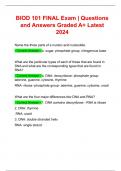BIOD 101 FINAL Exam | Questions
and Answers Graded A+ Latest
2024
Name the three parts of a nucleic acid nucleotide.
- Correct Answer - a. sugar, phosphate group, nitrogenous base
What are the particular types of each of these that are found in DNA and what are the corresponding types that are found in RNA? - Correct Answer - b. DNA- deoxyribose- phosphate group- adenine, guanine, cytosine, thymine
RNA- ribose -phosphate group- adenine, guanine, cytosine, uracil
What are the four major differences btw DNA and RNA? - Correct Answer - 1. DNA contains deoxyribose - RNA is ribose 2. DNA: thymine RNA: uracil 3. DNA: double stranded helix RNA: single strand DNA is often described as a coiled ladder. In this description, what
two parts of a DNA nucleotide form the uprights? What part forms the rungs? - Correct Answer - The uprights are the sugar phosphate backbone, and the rungs are the bases.
Explain the 2 differences btw hydrolysis and dehydration condensation. - Correct Answer - During dehydration condensation biomacromolecules are synthesized by joining building block monomers. A water molecule is lost and energy is used. Biomacromolecules are broken down into monomers during hydrolysis when a water molecule is added and energy is released.
Tell whether each of the following is carbohydrate, lipid, protein, or
nucleic acid. Then explain the use of each.
GLUCOSE - Correct Answer - Carbohydrate; used as fuel, is referred to as blood sugar in humans and animals
Tell whether each of the following is carbohydrate, lipid, protein, or
nucleic acid. Then explain the use of each.
Starch - Correct Answer - Carbohydrate; the form in which plants store glucose Tell whether each of the following is carbohydrate, lipid, protein, or
nucleic acid. Then explain the use of each.
Cellulose - Correct Answer - Carbohydrate; woody tissue in plants
and trees, indigestible fiber
Tell whether each of the following is carbohydrate, lipid, protein, or
nucleic acid. Then explain the use of each.
Triglyceride - Correct Answer - Lipid; the major form of fuel storage that when broken down produces twice as much energy per gram than carbohydrates
Tell whether each of the following is carbohydrate, lipid, protein, or
nucleic acid. Then explain the use of each.
Phopholipid - Correct Answer - Lipid; the major constituent of cell membranes
Tell whether each of the following is carbohydrate, lipid, protein, or
nucleic acid. Then explain the use of each.
Hemoglobin - Correct Answer - Protein; carries oxygen in the blood Tell whether each of the following is carbohydrate, lipid, protein, or
nucleic acid. Then explain the use of each.
DNA - Correct Answer - Nucleic Acid; contains genetic material of cells
Tell whether each of the following is carbohydrate, lipid, protein, or
nucleic acid. Then explain the use of each.
RNA - Correct Answer - Nucleic Acid; part of the protein-
synthesizing operation of the cell
Tell whether each of the following is carbohydrate, lipid, protein, or
nucleic acid. Then explain the use of each.
Cholesterol - Correct Answer - Lipid; component of animal cell membranes that, when in excess, can form plaque on artery walls
Tell whether each of the following is carbohydrate, lipid, protein, or
nucleic acid. Then explain the use of each.
ATP - Correct Answer - Nucleic Acid; releases energy through the breaking of high-energy phosphate bond
Tell whether each of the following is carbohydrate, lipid, protein, or
nucleic acid. Then explain the use of each.




